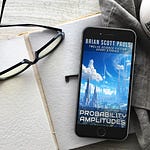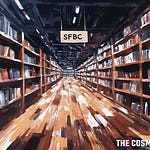
My novelette, An Illicit Mercy, is part of a new promotion in October: Fantasy & SciFi October Freebies.
Seventy science fiction and fantasy books, available at no cost.
As we have learned more about the difficulties of interstellar travel, writing believable stories set around other suns has become more challenging. This problem is a key part of the background in my new novelette, “Nasty, Brutish, and Short,” now appearing in Boundary Shock Quarterly 28: SF Horror, just in time for Halloween.
When the first expedition to the mysterious planet Janus takes a deadly turn, Lieutenant Carita Keahi must fight for survival against an alien ecosystem unlike anything humanity has ever encountered. As crew members fall victim to bizarre and lethal life forms, Keahi races against time to escape the dangers of this two-faced world. With mind-bending alien biology and gut-wrenching sacrifices, this tale of planetary exploration gone horribly wrong will keep you on the edge of your seat until the very last page. Prepare for a journey into the unknown that will challenge everything you thought you knew about life in the cosmos!
Here’s an excerpt:
“Nasty, Brutish, and Short”
by Brian Scott Pauls
“In such condition, there is…continuall feare, and danger of violent death; And the life of man, solitary, poore, nasty, brutish, and short.”
—Thomas Hobbes, Leviathan, i. xiii. 9
Our team took an aero down to the surface. Janus possesses the sort of thick atmosphere a planet (or in this case, half of one) needs to host a lush ecology. Or fly a plane.
What it doesn’t have is a moon. It’s got something a lot more exotic and terrifying—a micro black hole. This singularity occupies a geostationary orbit, circling its planet once every 38 hours, the length of a Janusian day. As it revolves, it spews out Hawking radiation—gamma rays, for the most part.
Beacon played no role in the choice of our first target. We didn’t know it existed until we arrived in-system. The Ibn Battuta only discovered it because one of their astronomers decided to point a gamma ray telescope at Keid Ab, the exoplanet we had come to investigate.
Even without an unidentified gamma source, standard operating procedure suggested only one ship approach the new world at first. “Suggested,” because you don’t write hard-and-fast rules for explorers 16 light years away and 182 years in the future. Still, the precaution made sense.
But which ship? The two captains worked it out between themselves. Maybe they played Rock Paper Scissors. In any case, the Zheng He drove in toward Janus while the Ibn Battuta stayed in the outer system, refining deuterium for the ships’ depleted tanks.
After reaching Keid Ab, we made it our priority to investigate Beacon. It didn’t take long to determine someone had constructed it.
First, no one has ever discovered a natural microscopic black hole.
Second, thousands of minuscule, identically sized, perfectly spherical comets fed mass to Beacon on a regular basis.
The Zheng He’s astronomers determined each micro comet—just the right size, spaced just far enough apart—added the same amount of mass to the black hole as it would lose to Hawking radiation before the next comet arrived. Their orbits all intersected the local kuiper belt. Someone had gone to a lot of trouble making sure the tiny black hole would be around for a long, long time.
Our physicists’ best guess as to the purpose of Beacon saw it as a power generator—an elaborate machine for converting ice from the fringes of the Keid A system into high-energy gamma rays for the Janusians.
Only it seemed there were no Janusians. At least, no intelligent Janusians. Not any more. Not for perhaps twelve thousand Earth years.
Our satellites and probes had no trouble locating the surface-based receiving station—a large dish antenna embedded in what used to be a mountain peak. It lay directly below Beacon, right where it should have been.
But whatever orbital infrastructure had originally harnessed the gamma rays to generate power and transmit it to the surface had vanished. The black hole orbited alone, undetectable except for its lethal output.
That’s how “Keid Ab” became “Janus.” Due to the hellish amount of radiation pouring out of Beacon, Janus was half dead, half alive. The side drenched in gamma rays appeared sterile. The opposite side teamed with life. Janus, the two-faced Roman god of duality, seemed like a good match.
We didn’t know for sure what had happened to the orbital station that must have existed. But the surface of Janus offered clues. Both hemispheres showed the remains of blast craters.
The aero swooped in.
As soon as we’d dropped low enough to get a good look, Nabih grunted,
“Looks like the bio team was right, Martin. The place is a jungle.”
“‘Jungle’ is too plant-centric,” replied the astrobiologist. “Those almost certainly aren’t plants, even if they do use photosynthesis. They probably don’t fit into any of our kingdoms of life. A better term would be the ‘bush’—just ‘uncultivated country.’”
It looked like a jungle to me—or at least something analogous to a jungle. But Martin was the science guy. If he wanted to call it the “bush,” the bush it would be.
Most of it looked black. With the exceptions of a few clearings and exposed hilltops, ebon organisms covered the ground, reaching upward to absorb what they could of Keid A’s dim, orange light. Here and there, I saw splashes of other colors. But they amounted to mere accents in a sable sea.
In school, I’d learned under an orange sun photosynthesizing organisms would evolve to use all wavelengths of the limited light they received. Reflecting any would waste precious energy. But I found knowing to be different from seeing. Beneath Janus’ orange sky, a midnight landscape stretched to the horizon—every day dawned as a new All Hallows Eve.
We set down close to the edge of a small plateau. The taller organisms didn’t encroach on this open space, but crowded close on every side. It seemed the slopes made fertile ground for larger species. And while, seen from above, these were black, underneath they were quite pale. This made sense. Only the parts facing Keid A could capture sunlight.
The flat top of the plateau was reddish-brown, punctuated here and there by meter-wide, yellow puff balls. Not every organism was a photosynthesizer.
Nabih glanced at Martin. “This is your area of expertise.”
The biologist had already unstrapped—a breach of protocol, but Nabih didn’t make an issue of it. Martin represented the closest we had to an expert in this environment. Under the circumstances, our commander seemed comfortable with his over-enthusiasm.
“Unstrap,” he told the rest of us. “And seal up.”
If you’ve enjoyed this excerpt from “Nasty, Brutish, and Short”, you can read the entire story in Boundary Shock Quarterly 28: SF Horror, available at Amazon and other online booksellers.
Questions or comments? Please share your thoughts!















